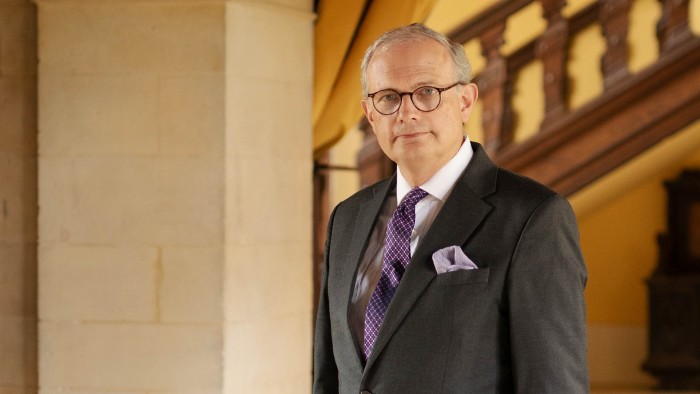The writer is a historian and public speaker
“We once had seven castles,” says Jean Christophe, Baron von Pfetten. “All were sold — so I’ve bought one back!”
The baron, a Frenchman with a Germanic title and a deep love of England, blames the loss of his family’s patrimony on the Code Napoleon, which prescribes a more equitable family inheritance and quickly disperses an ancestral fortune.
So, when he first picked his way through Apethorpe House, the castle in question, and spotted a carved coat of arms resembling his own, he and his wife Nadia, a conservation architect from Venice, decided to buy it.
The seller was English Heritage, a charity charged with managing a portfolio of 400-plus properties — including Stonehenge and parts of Hadrian’s Wall — with the aim to “bring the story of England to life”. Apethorpe, a many-courtyarded mansion set in four acres of Northamptonshire countryside, 85 miles north of London, was so tarnished that the 2014 selling price was said to be £2.5mn.
Since 1900, 1,200 English and nearly 400 Scottish country houses have been destroyed, a casualty rate that has led to the inception, or increased intervention, of conservation bodies such as English Heritage and the National Trust. The challenge for them is that owners of historic houses can be nervous of handing over the properties, fearing they will become nothing more than unwelcome tenants in their homes. But two different examples show that it can be a relationship that works well for both sides.
After the baron, who has a colourful background as a diplomat and international broker, having arranged talks on Iran’s nuclear programme, acquired the freehold of Apethorpe House, it was renamed Apethorpe Palace in a nod to its royal history. Bequeathed to Elizabeth I by Henry VIII, it became a favourite hunting lodge of her successors; Apethorpe was where James I met the handsome George Villiers, whom he made the Duke of Buckingham and who was probably his lover.
The baron and his wife have made the place their own, decking the walls with 50 tapestries, and they enjoy the run of the palace: “It’s a family home, and we live in the state apartments,” the baron says. “It’s important for the children to live in it, and love it.” He expects them to call it home, after his time.
English Heritage invested at least £8mn in the fabric of the place — rendering it waterproof — and the baron has continued the renovation from his own funds, claiming to have spent £15mn. He has also opened it to pre-booked parties for 50 days in July and August. So this is a win for the historic house owner and visitors.
Closer to London is West Wycombe Park, the beautiful Palladian mansion of the Dashwood family. In 1943, James Lees-Milne, secretary of the country house committee of the National Trust and a lodger at the house, succeeded in persuading his landlord, Sir John Dashwood, that its only possible future lay with the National Trust.
Sir John agreed to hand over the house without consulting his son, who was serving overseas and remained bitter about being excluded from the decision over his inheritance. He did it in the hope he and his family could continue to live in it in perpetuity, without the burdens the mansion might incur. They would continue to own the landed estate and the house’s contents. In return, West Wycombe Park would open to the public one day a week.
“That arrangement was no good to anyone,” says Sir Edward Dashwood, Sir John’s grandson, because of its intrusion. “The house is now open to the public for the three summer months.”
Sir Edward is an entrepreneur who has built on his public obligations with notable success — the walled garden (and its restaurant), one of England’s best known shooting schools and the rental of the Hellfire Caves, where an 18th-century ancestor gave hedonism a good go, bring in a lot of money.
When Sir Edward allows filming at West Wycombe Park, the revenue goes to him, but he ensures it is spent at West Wycombe and shares it with the National Trust. This year, he has paid for the public loos to be overhauled.
It is a relationship that benefits family and organisation. “Funnily enough,” Sir Edward says, “we get on extremely well with the National Trust team on the ground. They have great conservation skills and do know how to get such things done.” At the same time, he shares his no-nonsense approach with them: when they threatened to surround parts of the house with scaffolding for four years, repointing and painting one elevation at a time, he cajoled them into doing the whole place in one year.
It is not all smooth. One tenant of the National Trust tells me it is “unbelievable how much time is wasted in email correspondence and waiting for the outcome of interminable committee meetings — the curse of an organisation that thrives on mindless bureaucracy”.
Nevertheless, English Heritage and the National Trust each has a success story here. Apethorpe attracted new overseas owners to assist in the restoration of a palace in peril. West Wycombe Park benefits handsomely from the enterprise of the heir to its historical owners, who is happy to share the helm with knowledgeable experts. But the real winners are the houses themselves: saved from an oblivion that seemed acceptable many decades ago, protected by a common passion to preserve.
